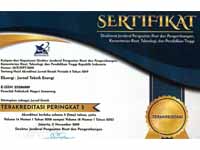Performance Characteristics of Savonius Wind Turbines With Variations Air Gaps in Supporting the Development of Renewable Energy
DOI:
https://doi.org/10.32497/eksergi.v19i01.4252Abstract
To overcome the occurrence of an energy crisis in the future, an innovation / invention of energy that is environmentally friendly and energy sources will not run out in the future. Energy sources that are environmentally friendly and their potential when developed is very large, one of which is energy sources derived from wind energy. This study aims to determine the effect of wind speed on the performance of wind turbines. To find out the performance characteristics of wind turbines with variations in air gaps. The research method begins with the design / design of the wind turbine, then continues the manufacturing stage, the assembling and installation stage, the testing of tools and analysis, the tests carried out include testing the performance characteristics of the wind turbine. The parameters measured in this study are rotation, torque as well as calculating the kinetic power produced, TSR and CP. The test results conducted showed that the 200 mm air gap Savonius wind turbine with a value of CP = 0.02480-0.15658 had optimum work at low wind speeds (4 m / s). Meanwhile, the 170 mm airborne Savonius wind turbine with a value of CP = 0.00593-0.14668 has optimum work at high wind speeds (8 m / s to 9 m / s).Keywords- wind turbine savonius, air gap, coefficent of power.
References
Taher, G, etal. 2014. Investigation of the Aerodynamic Performance of Darrieus Vertical Axis Wind Turbine.IOSR Journal of Engineering. Vol (04), Issue 05
Dikky Rizaldi, et al. 2019. Rancang Bangun Turbin Angin Savonius Tiga Tingkat Dengan Sudut 120o Sebagai Penggerak Mula Pembangkit Listrik Tenaga Angin. Tugas Akhir. Semarang: Jurusan Teknik Mesin Polines
Chandra, Daniel, etal. Rancang Bangun Turbin Aangin Savonius-Darrieus Tipe Cebong.. Prosiding Seminar Nasional NCIET. Vol. 1. No. 1. 2020
Fadila Anisa, etal. 2019. Rancang Bangun Turbin Darrieus Tiga Sudu Rangkap Tiga dengan Profil NACA 0006. Jurnal Teknik Energi Vol 15 No.3 September 2019; 102-114
Hicary, H., Suwandi, S., & Qurthobi, A. 2016. Analisis Pengaruh Jumlah Sudu Pada Turbin Angin Savonius Sumbu Vertikal Terhadap Tegangan Dan Arus Di Dalam Proses Pengisian Akumulator. eProceedings of Engineering, 3(3)
Lysen, E. H, 1983. Introduction to Wind Energy, Basic and Advance Introduction to Wind Energy With Emphasis on Water Pumping Windmills. Development Cooperation Departement. Netherland
Pamungkas, Stephanus Fajar. etal. 2017.Pengaruh Variasi Penambahan Fin Terhadap Cut In Speed Turbin Angin Savonius Tipe S. Vol. 2, No. 1 (2017)
Pangestu, R. Sandri, A. A. H. 2017. Perancangan Turbin Angin Peros Vertikal Tipe Savonius Bertingkat dengan Variasi Blade “Savonius Helical L Rotor”. 10.13140/Research Gate.2.2.14852.73600
Prasetyo, Yuli, and Nur Asyik Hidayatullah. "Analisa Karakteristik Turbin Angin Sumbu Vertikal Tipe Savonius Helius."JEECAE (Journal of Electrical, Electronics, Control, and Automotive Engineering)4.1 (2019): 241-244
Sahid, Slamet Priyoatmojo. 2019. Rancang Bangun Turbin Angin Poros Horizontal Tiga Sudu Flat Berlapis Tiga Dengan Variasi Sudut dan Posisi Sudu. Jurnal Teknik Energi Vol 15 No.1 Januari 2019; 14-19
Sahid, et al. 2019. Smart wind turbine three-layers flat blade with control system Arduino-based for blade angle. International Conference on Innovation in Science and Technology (ICIST 2019) Jilid 1108
Siregar, S. Farel H. Napitupulu. 2013. Perancangan Turbin Vertikal Axis Savonius dengan Menggunakan 8 Buah Sudu Lengkung. Jurnal dinamis Vol.I,No.13,Juni2013
Sumarno Gatot F, et al. 2021. Uji Eksperimental optimasi turbin angin savonius tipeS untuk menunjang pemanfaatan energi ramah lingkungan. Prosiding NCIET Vol.2 (2021) B142 ”“B150
Sumarno Gatot F, et al. 2020. Rancang Bangung Turbin Angin Archimedes Dengan Dua Sudu. Jurnal Teknik Energi Vol.16 No.2 Mei 2020; 49-59
Sumarno Gatot F, et al. 2020. Studi karakteristik turbin angin savonius bertingkat dengan sudut sudu 120 ° Sebagai Pembangkit Listrik Alternatif. Prosiding Seminar Nasional NCIET Vol.1 (2020) B359-B373
Downloads
Additional Files
Published
Issue
Section
License
Authors who publish with this journal agree to the following terms:Authors retain copyright and grant the journal right of first publication with the work simultaneously licensed under a Creative Commons Attribution License that allows others to share the work with an acknowledgement of the work's authorship and initial publication in this journal.
Authors are able to enter into separate, additional contractual arrangements for the non-exclusive distribution of the journal's published version of the work (e.g., post it to an institutional repository or publish it in a book), with an acknowledgement of its initial publication in this journal.
Authors are permitted and encouraged to post their work online (e.g., in institutional repositories or on their website) prior to and during the submission process, as it can lead to productive exchanges, as well as earlier and greater citation of published work (See The Effect of Open Access).






